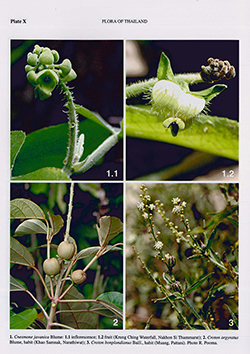e-Flora of Thailand
Volume 8 > Part 1 > Year 2005 > Page 195 > Euphorbiaceae > Croton
3. Croton bonplandianus Baill.wfo-0000927482
Adansonia 4: 339. 1863-4; Müll.Arg. in DC., Prodr. 15(2): 661. 1866 (under C. persicaria); Croizat, J. Bombay Nat. Hist. Soc. 41: 573. 1940: Radcl.-Sm., Fl. Pakistan 172: 43. 1986; Fl. Trop. East Afr., Euphorbiac. 1: 159. 1987; Bansiddhi, Nat. Hist. Bull. Siam Soc. 42: 79. 1994; Chakrab. & N.P.Balakr., Bull. Bot. Surv. India 34: 31. 1997 (‘1992’). Plate X: 3.
Accepted Name : This is currently accepted.
Synonyms & Citations :
Description : Erect herb or subshrub, up to 1 m high; initially densely pubescent, later on glabrous. Indumentum consisting of stellate, whitish hairs (appearing as white dots), flat, 0.3–0.5 mm in diam., with (8–)10–15 free radii. Stipules ca 0.5 mm long, filiform, subglabrous. Leaves mostly pseudo-verticillate, sometimes alternate; petiole 0.5–1.2 cm long, initially densely pubescent, glabrescent; blade ovate-elliptic to lanceolate, 3–5.5 by 1–2 cm, index 1.5–3.5, membranous, base obtuse, margin serrate, apex acute to mucronate, with both sides of nearly same colour, initally pubescent on both sides, glabrescent; basal glands lateral on abaxial midrib base as a pair of prominent but sessile discs 0.3–0.5 mm in diam.; venation only visible below, side veins 6–7 pairs, basal pair different (triplinerved). Inflorescences creamy-white, 4–12 cm long, with 2–7 pistillate flowers, without bisexual bracts; sparsely pubescent to subglabrous except for the distinctly pubescent ovaries; bracts ca 1 mm long, with a distinct pair of pillow-shaped glands ca 0.5 mm in diam., in staminate part often eglandular. Staminate flowers subglabrous to glabrous outside; pedicel 1–1.5 mm long; sepals 1–1.25 by 1 mm; petals ca 1.5 by 0.5 mm; stamens 13–16, filaments glabrous. Pistillate flowers: pedicel nearly absent (ca. 0.25 mm, 0.5 mm in fruit), subglabrous; sepals ca 1 mm long, subglabrous, shorter than the ovary; petals absent; ovary ca 1.5 mm long, very densely pubescent; stigmas free, 1.5–2 mm long, bifid for most (more than half) of their length. Fruits brownish-green, 5.5–6 by 4–4.5 mm, oblong, sulcate, thin-walled, initially densely pubescent but soon glabrescent. Seeds ca 4–5 by 2–3 mm, grey-blackish-brown, nearly smooth (finely rugulose), carunculate.
Thailand : EASTERN: Nakhon Ratchasima (Sikhio); SOUTH-WESTERN: Kanchanaburi (Lao Khwan), Phetchaburi (Cha-Am), Prachuap Khiri Khan (Hua Hin, Muang); CENTRAL: Sing Buri, Suphan Buri (U Thong), Ang Thong (Chai Yo), Phra Nakhon Si Ayutthaya, Nakhon Pathom (Khampaeng Saen), Krung Thep Maha Nakhon (Bangkok) (Bang Khen); SOUTH-EASTERN: Chachoengsao (Phranom Sarakham); PENINSULAR: Narathiwat (Tak Bai).
Distribution : Native to S America (from Bolivia to Argentina, type from Argentina), introduced and naturalizing in Africa (Kenya), SE Asia from Pakistan to Laos, Malay Peninsula (including Singapore), Borneo, Sulawesi, and probably further.
Ecology : Weed on waste places, roadsides, paddy or sugar cane fields, seashores, on sand or sandy clay, sea level to ca 100 m alt. Flowering and fruiting: April, August, September, December (the whole year through?).
Vernacular : Plao thung (เปล้าทุ่ง).

